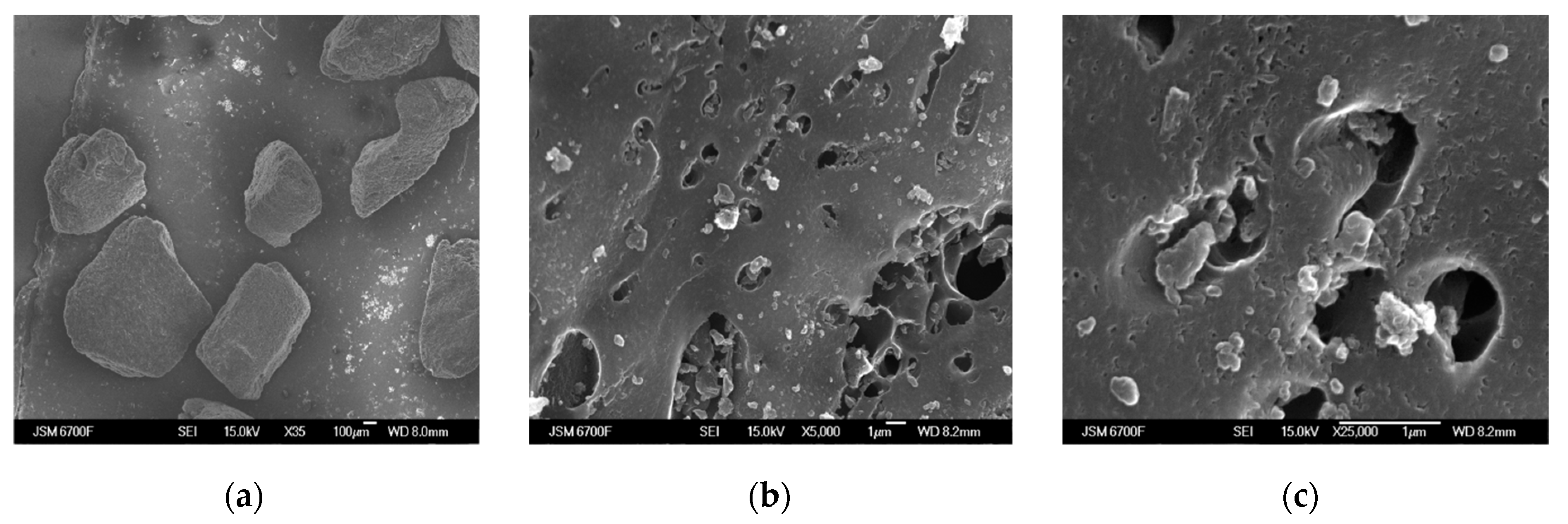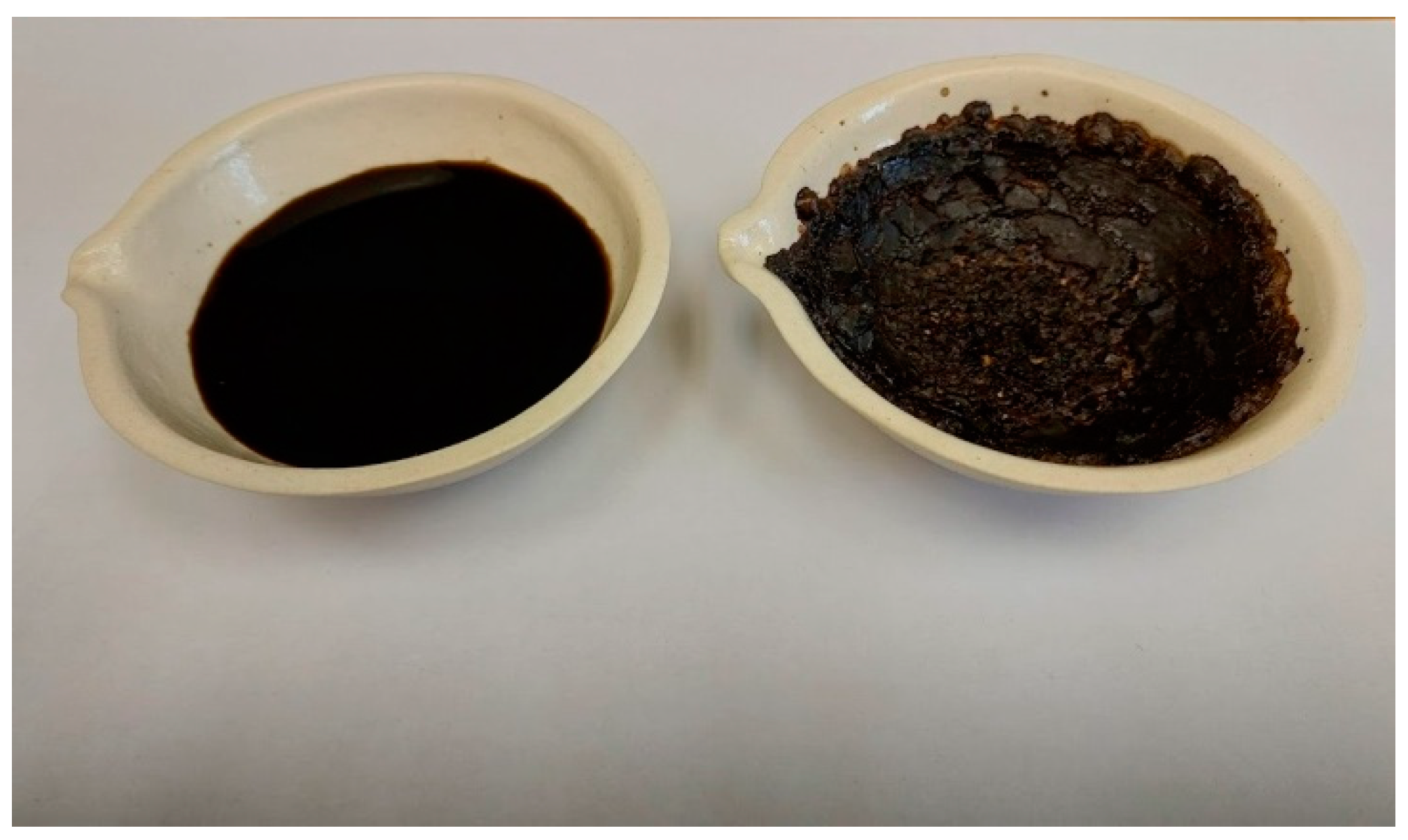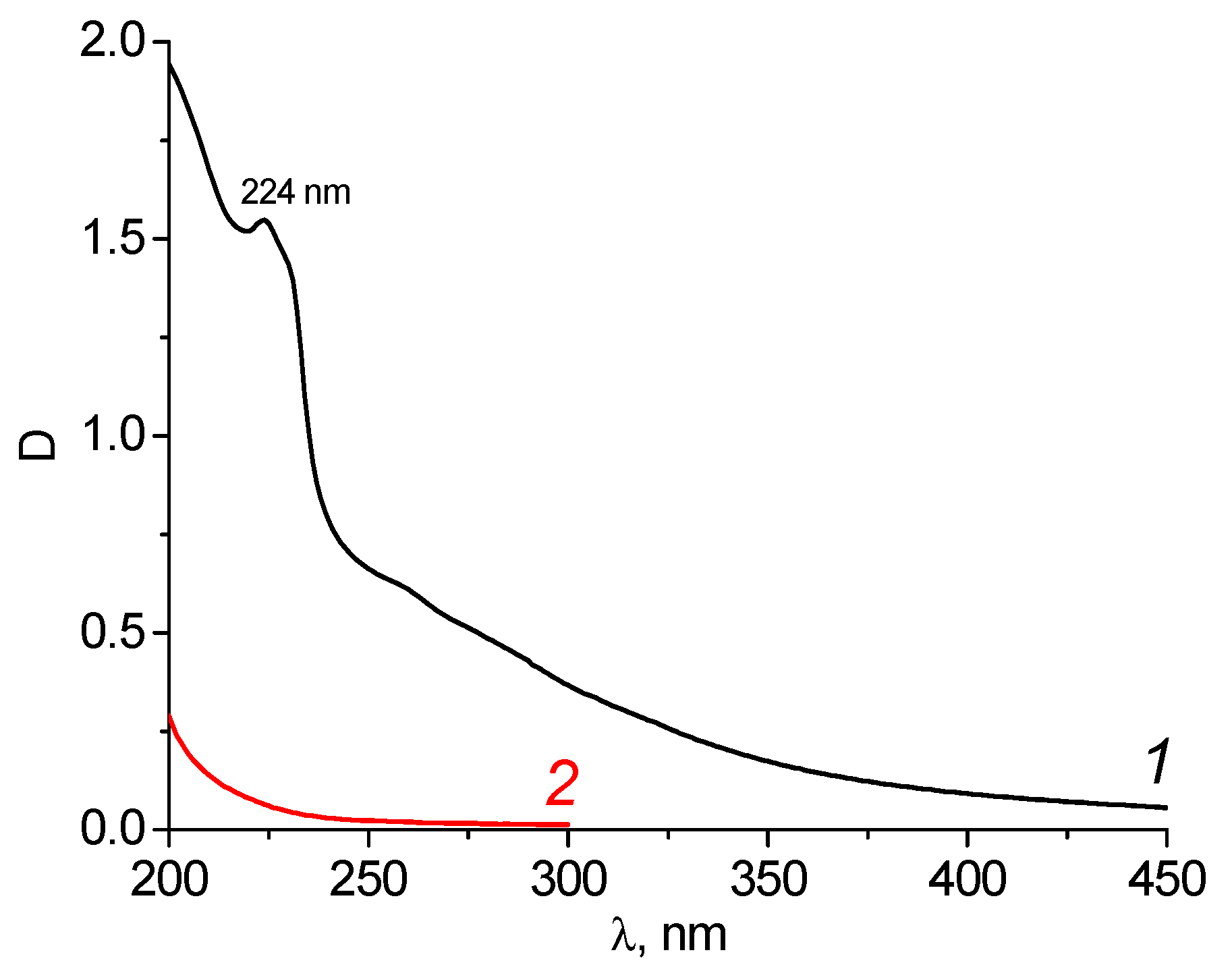Removal of Aromatic Compounds from Wastewater of “Rubizhanskyi” Storage Facility Using Carbon Adsorbents †
Abstract
1. Introduction
2. Methods
3. Results and Discussion
4. Conclusions
Author Contributions
Funding
Institutional Review Board Statement
Informed Consent Statement
Data Availability Statement
Acknowledgments
Conflicts of Interest
References
- Nikolaieva, I.; Lenko, H.; Lobodzinskyi, O. Donbas Tailings Storage Facilities. Available online: https://www.osce.org/files/f/documents/2/5/456844.pdf (accessed on 5 March 2025).
- Hao, O.J.; Kim, H.; Chang, P.-C. Decolorization of Wastewater. Crit. Rev. Environ. Sci. Technol. 2000, 30, 449–505. [Google Scholar] [CrossRef]
- Mikhalkova, N.; Kononenko, A.; Udalov, I. Analysis of the influence of technogenic facilities of the Lysychansk-Rubizhne industrial hub on the ecological state of the natural environment. Visnyk V.N. Karazin Kharkiv Natl. Univ. Ser. Geol. Geography. Ecol. 2022, 56, 225–239. [Google Scholar] [CrossRef]
- Nikolaieva, I.; Lenko, A.; Averin, D.; Lobodzinsky, A. Doslidjennya Potochnogo Stanu Chvostoschovyshch u Donerskii ta Luganskii Oblastyach. Available online: https://www.osce.org/files/f/documents/9/9/486259.pdf (accessed on 5 March 2025). (in Russian).
- Farbun, I.A.; Kovalchuk, I.A.; Khalyavka, T.A.; Tsyba, M.M.; Camychan, S.V. Organic Pollutants Removal from Wastewater in Rubizhne City, Ukraine. In Proceedings of the XVI International Scientific Conference «Monitoring of Geological Processes and Ecological Condition of the Environment», Kyiv, Ukraine, 15–18 November 2022; pp. 1–5. [Google Scholar]
- Marsh, H.; Rodrigues-Reinoso, F. Activated Carbon; Elsevier Science and Technology Books: Oxford, UK, 2006; 536p. [Google Scholar]
- Ho, S. Removal of Dyes from Wastewater by Adsorption onto Activated Carbon: Mini Review. J. Geosci. Environ. Prot. 2020, 8, 120–131. [Google Scholar] [CrossRef]
- Sych, N.V.; Trofymenko, S.I.; Poddubnaya, O.I.; Tsyba, M.M.; Sapsay, V.I.; Klymchuk, D.O.; Puiy, A.M. Porous structure and surface chemistry of phosphoric acid activated carbon from corncob. Appl. Surf. Sci. 2012, 261, 75–82. [Google Scholar] [CrossRef]
- Sych, N.V.; Vikarchuk, V.M.; Kupchyk, L.A.; Fedorishin, A.S.; Kravchenko, O.V. Advances in B(III) Removal by Adsorption on Nanoporous Carbon of Lignocellulosic Origin and Its Surface Modified Analogue. Nanosistemi Nanomater. Nanotehnol. 2021, 19, 629–638. [Google Scholar]
- Sych, N.V.; Kotynskaya, L.I.; Vikarchuk, V.M.; Tsyba, M.M.; Kovtun, M.F. Sorption of Phenolic Acids on Powdered Carbon Prepared by Complex Processing of Spent Coffee Grounds. Phys. Chem. Water Treat. Process. 2020, 42, 88–93. [Google Scholar] [CrossRef]
- Khu, L.V.; Thuy, L. Preparation of Pore Size Controllable Activated Carbon from Rice Husk Using Dual Activating Agent and Its Application in Super Capacitor. J. Chem. 2019, 5, 1–11. [Google Scholar]
- John, K.; Lin, S.; Amit, K.; Zhao, Y.; Choi, J.; Song, M.; Cho, C.; Yun, Y. Evaluation of Orange Peel Derived Activated Carbons for Treatment of Dye Contaminated Wastewater Tailings. Environ. Sci. Pollut. Res. 2020, 27, 1053–1068. [Google Scholar]
- Yu, Q.; Ning, P.; Li, M.; Tang, X. Characterization of Metal Oxide Modified Walnut Shell Activated Carbon and Its Application for Phosphine Adsorption: Equilibrium, Regeneration and Mechanism Studies. J. Wuhan Univ. Technol.-Mater. Sci. Ed. 2019, 34, 487–495. [Google Scholar] [CrossRef]
- Mahanta, V.; Raja, M.; Kothandaraman, R. Activated Carbon from Sugarcane Bagasse as a Potential Positive Electrode Catalyst for Vanadium Redox Flow Battery. Mater. Lett. 2019, 247, 63–66. [Google Scholar] [CrossRef]
- Karnan, M.; Subramani, K.; Sudhan, N.; Sathish, M.; Ilayaraja, N. Aloe Vera Derived Activated High Surface Area Carbon for Flexible and High Energy Supercapacitors. ACS Appl. Mater. Interfaces 2016, 8, 35191–35202. [Google Scholar] [CrossRef] [PubMed]
- Jawad, A.H.; Razuan, R.; Jimmy, N.; Lee, D. Adsorption and Mechanism Study for Methylene Blue Dye Removal with Carbonized Watermelon (Citrullus lanatus) Rind Prepared via One Step Liquid Phase H2SO4 Activation. Surf. Interfaces 2019, 16, 76–84. [Google Scholar] [CrossRef]
- Activated Carbon Market Size, Share & COVID-19 Impact Analysis, by Type (Powdered, Granular, and Others), by Application (Water Treatment, Air & Gas Purification, Food & Beverage, Pharmaceutical & Healthcare Treatment, and Others), and Regional Forecast, 2024–2032. Available online: https://www.fortunebusinessinsights.com/activated-carbon-market-102175 (accessed on 17 February 2025).
- Trykhlib, V.A.; Strelko, V.V. Method of Producing of Micro- and Mesoporous Carbon Adsorbent. U.S. Patent 109548, 25 August 2016. [Google Scholar]
- Standard Methods for the Examination of Water and Wastewater, 22nd ed.; Bridgewater, L., Rice, E.W., Baird, R.B., Eaton, A.D., Clesceri, L.S., Eds.; APHA-AWWA-WEF: Washington, DC, USA, 2012; 1496p. [Google Scholar]
- Bauer, K.H.; Moll, H. Die organische Analyse., Geest & Portig: Leipzig, Germany, 1954; p. 151. Available online: https://www.zvab.com/organische-Analyse-Bauer-Karl-Hugo-Heinrich/22631011246/bd (accessed on 17 February 2025).
- Sing, K.S.W.; Everett, D.H.; Haul, R.A.W.; Moscou, L.; Pierotti, R.A.; Rouquerol, J.; Siemieniewska, T. Reporting physisorption data for gas/solid systems with special reference to the determination of surface area and porosity. Pure Appl. Chem. 1985, 57, 603–619. [Google Scholar] [CrossRef]
- Farbun, I.A.; Trykhlib, V.A.; Tsyba, M.M. Characteristics of the sorption of aromatic and heterocyclic amino acids by activated coconut carbons with different bulk density. Vopr. Khimii I Khimicheskoi Tekhnologii 2020, 129, 125–133. [Google Scholar]
- Dawson, R.M.C.; Elliott, D.C.; Elliott, W.H.; Jones, K.M. Data for Biochemical Research, 3rd ed.; Oxford University Press: Oxford, England, 1986; 580p. [Google Scholar]
- Li, Y.; Xing, B.; Wang, X.; Wang, K.; Zhu, L.; Wang, S. Nitrogen-doped hierarchical porous biochar derived from corn stalks for phenol-enhanced adsorption. Energy Fuels 2019, 33, 12459–12468. [Google Scholar] [CrossRef]
- Tamarkina, Y.V.; Anishchenko, V.M.; Red’ko, A.M.; Kucherenko, V.O. Alkali activated coals. Microporous structure and capability to adsorb phenol compounds. Chem. Phys. Technol. Surf. 2022, 13, 111–124. [Google Scholar]
- Zuo, L.; Wenzhe, S.; Taihong, S.; Lv, C.; Yao, J.; Liu, J.F.; Weng, Y. Adsorption of aniline on template-synthesized porous carbons. Microporous Mesoporous Mater. 2014, 200, 174–181. [Google Scholar] [CrossRef]






| Adsorbent | Ssp.(BET), m2/g | Vtot. (BET), sm3/g | Vmicro (BJH), sm3/g | Micro-porous, % | raver. (BET), nm |
|---|---|---|---|---|---|
| KARBON™ | 1730 | 0.92 | 0.76 | 82.6 | 1.1 |
| ZL-302 | 1523 | 1.04 | 0.55 | 52.9 | 1.4 |
Disclaimer/Publisher’s Note: The statements, opinions and data contained in all publications are solely those of the individual author(s) and contributor(s) and not of MDPI and/or the editor(s). MDPI and/or the editor(s) disclaim responsibility for any injury to people or property resulting from any ideas, methods, instructions or products referred to in the content. |
© 2025 by the authors. Licensee MDPI, Basel, Switzerland. This article is an open access article distributed under the terms and conditions of the Creative Commons Attribution (CC BY) license (https://creativecommons.org/licenses/by/4.0/).
Share and Cite
Farbun, I.; Kovalchuk, I. Removal of Aromatic Compounds from Wastewater of “Rubizhanskyi” Storage Facility Using Carbon Adsorbents. Eng. Proc. 2024, 67, 84. https://doi.org/10.3390/engproc2024067084
Farbun I, Kovalchuk I. Removal of Aromatic Compounds from Wastewater of “Rubizhanskyi” Storage Facility Using Carbon Adsorbents. Engineering Proceedings. 2024; 67(1):84. https://doi.org/10.3390/engproc2024067084
Chicago/Turabian StyleFarbun, Iryna, and Iryna Kovalchuk. 2024. "Removal of Aromatic Compounds from Wastewater of “Rubizhanskyi” Storage Facility Using Carbon Adsorbents" Engineering Proceedings 67, no. 1: 84. https://doi.org/10.3390/engproc2024067084
APA StyleFarbun, I., & Kovalchuk, I. (2024). Removal of Aromatic Compounds from Wastewater of “Rubizhanskyi” Storage Facility Using Carbon Adsorbents. Engineering Proceedings, 67(1), 84. https://doi.org/10.3390/engproc2024067084






